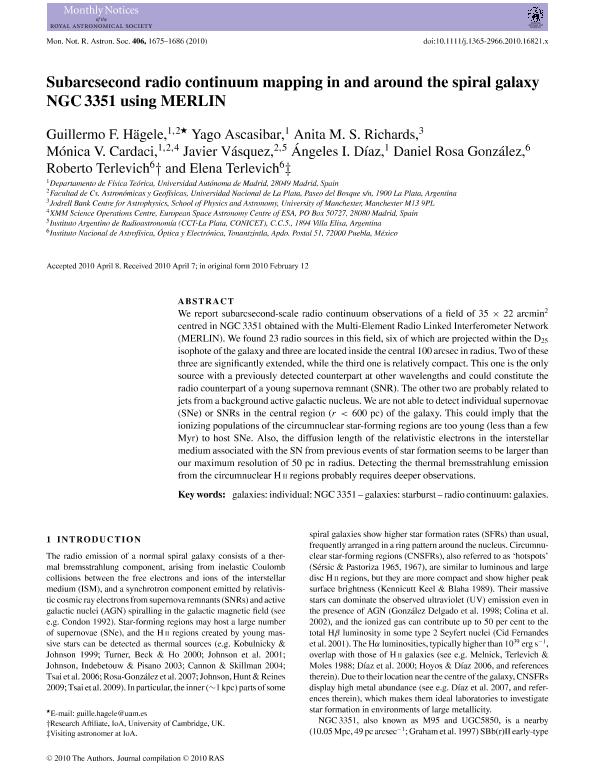Mostrar el registro sencillo del ítem
dc.contributor.author
Hägele, Guillermo F.
dc.contributor.author
Ascasibar, Yago
dc.contributor.author
Richards, Anita M. S.
dc.contributor.author
Cardaci, Monica Viviana

dc.contributor.author
Vásquez, Javier
dc.contributor.author
Díaz, Ángeles I.
dc.contributor.author
Rosa González, Daniel
dc.contributor.author
Terlevich, Roberto
dc.contributor.author
Terlevich, Elena
dc.date.available
2016-07-01T21:16:32Z
dc.date.issued
2010-08
dc.identifier.citation
Hägele, Guillermo F.; Ascasibar, Yago; Richards, Anita M. S.; Cardaci, Monica Viviana; Vásquez, Javier; et al.; Subarcsecond radio continuum mapping in and around the spiral galaxy NGC3351 using MERLIN; Wiley; Monthly Notices of the Royal Astronomical Society; 406; 3; 8-2010; 1675-1686
dc.identifier.issn
0035-8711
dc.identifier.uri
http://hdl.handle.net/11336/6314
dc.description.abstract
We report subarcsecond-scale radio continuum observations of a field of 35 × 22 arcmin2 centred in NGC 3351 obtained with the Multi-Element Radio Linked Interferometer Network (MERLIN). We found 23 radio sources in this field, six of which are projected within the D25 isophote of the galaxy and three are located inside the central 100 arcsec in radius. Two of these three are significantly extended, while the third one is relatively compact. This one is the only source with a previously detected counterpart at other wavelengths and could constitute the radio counterpart of a young supernova remnant (SNR). The other two are probably related to jets from a background active galactic nucleus. We are not able to detect individual supernovae (SNe) or SNRs in the central region (r < 600 pc) of the galaxy. This could imply that the ionizing populations of the circumnuclear star-forming regions are too young (less than a few Myr) to host SNe. Also, the diffusion length of the relativistic electrons in the interstellar medium associated with the SN from previous events of star formation seems to be larger than our maximum resolution of 50 pc in radius. Detecting the thermal bremsstrahlung emission from the circumnuclear H II regions probably requires deeper observations.
dc.format
application/pdf
dc.language.iso
eng
dc.publisher
Wiley

dc.rights
info:eu-repo/semantics/openAccess
dc.rights.uri
https://creativecommons.org/licenses/by-nc-sa/2.5/ar/
dc.subject
Ngc3351 (Galaxia)
dc.subject
Radio Continuum
dc.subject
Starbursts
dc.subject.classification
Astronomía

dc.subject.classification
Ciencias Físicas

dc.subject.classification
CIENCIAS NATURALES Y EXACTAS

dc.title
Subarcsecond radio continuum mapping in and around the spiral galaxy NGC3351 using MERLIN
dc.type
info:eu-repo/semantics/article
dc.type
info:ar-repo/semantics/artículo
dc.type
info:eu-repo/semantics/publishedVersion
dc.date.updated
2016-06-15T19:20:37Z
dc.journal.volume
406
dc.journal.number
3
dc.journal.pagination
1675-1686
dc.journal.pais
Estados Unidos

dc.journal.ciudad
Hoboken
dc.conicet.avisoEditorial
This article has been accepted for publication in MRAS ©: 2010 The autors Published by Oxford University Press on behalf of the Royal Astronomical Society. All rights reserved.
dc.description.fil
Fil: Hägele, Guillermo F.. Universidad Autónoma de Madrid. Departamento de Física Teórica; España. Universidad Nacional de la Plata. Facultad de Ciencias Astronómicas y Geofísicas; Argentina
dc.description.fil
Fil: Ascasibar, Yago. Universidad Autónoma de Madrid. Departamento de Física Teórica; España
dc.description.fil
Fil: Richards, Anita M. S.. University of Manchester. Jodrell Bank Centre for Astrophysics. School of Physics and Astronomy; Reino Unido
dc.description.fil
Fil: Cardaci, Monica Viviana. Universidad Autónoma de Madrid. Departamento de Física Teórica; España. Universidad Nacional de la Plata. Facultad de Ciencias Astronómicas y Geofísicas; Argentina. XMM Science Operations Centre, European Space Astronomy Centre of ESA; España
dc.description.fil
Fil: Vásquez, Javier. Consejo Nacional de Investigaciones Científicas y Técnicas. Centro Científico Tecnológico La Plata. Instituto Argentino de Radioastronomia (i); Argentina. Universidad Nacional de la Plata. Facultad de Ciencias Astronómicas y Geofísicas; Argentina
dc.description.fil
Fil: Díaz, Ángeles I.. Universidad Autónoma de Madrid. Departamento de Física Teórica; España
dc.description.fil
Fil: Rosa González, Daniel. Instituto Nacional de Astrofísica, Optica y Electrónica, Tonantzintla; México
dc.description.fil
Fil: Terlevich, Roberto. Instituto Nacional de Astrofísica, Optica y Electrónica, Tonantzintla; México
dc.description.fil
Fil: Terlevich, Elena. Instituto Nacional de Astrofísica, Optica y Electrónica, Tonantzintla; México
dc.journal.title
Monthly Notices of the Royal Astronomical Society

dc.relation.alternativeid
info:eu-repo/semantics/altIdentifier/url/http://mnras.oxfordjournals.org/content/406/3/1675
dc.relation.alternativeid
info:eu-repo/semantics/altIdentifier/doi/http://dx.doi.org/10.1111/j.1365-2966.2010.16821.x
dc.relation.alternativeid
info:eu-repo/semantics/altIdentifier/doi/10.1111/j.1365-2966.2010.16821.x
dc.relation.alternativeid
info:eu-repo/semantics/altIdentifier/url/http://onlinelibrary.wiley.com/doi/10.1111/j.1365-2966.2010.16821.x/abstract
Archivos asociados
